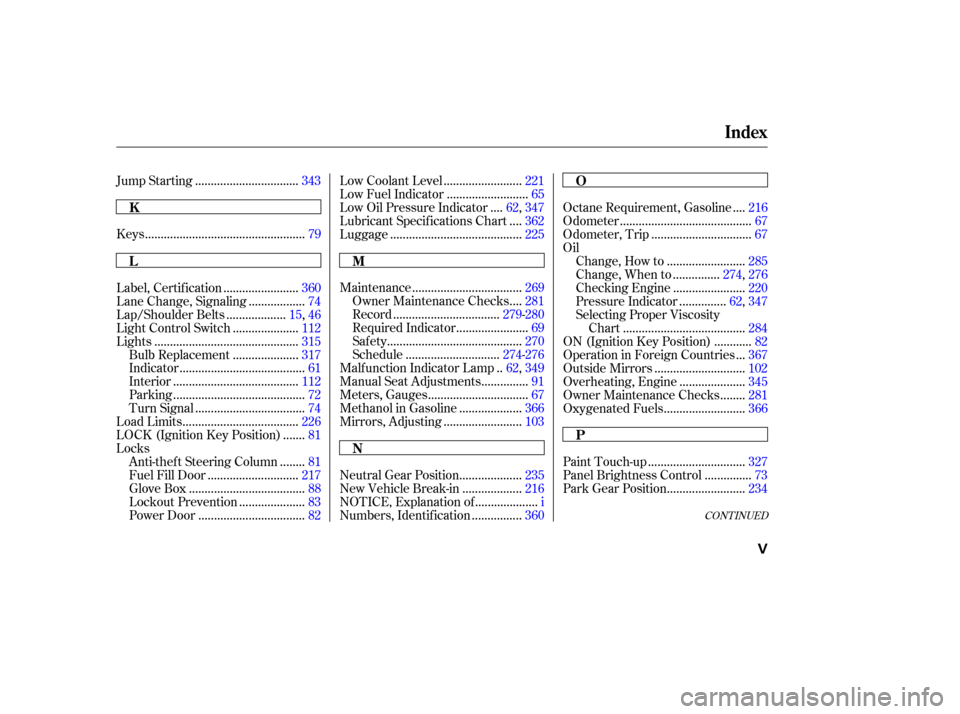Page 299 of 392
The f luid level should be between
theMINandMAXmarksontheside
of the reservoir. If the level is at or
below the MIN mark, your brake
system needs attention. Have the
brake system inspected f or leaks or
worn brake pads.
Always use Honda Heavy Duty
Brake Fluid DOT 3. If it is not
available, you should use only DOT 3
or DOT 4 f luid, f rom a sealed
container, as a temporary
replacement. However, the use of
any non-Honda brake fluid can cause
corrosion and decrease the lif e of the
system. Have the brake system
f lushed and ref illed with Honda
Heavy Duty Brake Fluid DOT 3 as
soon as possible.
Check the f luid level in the brake
f luid reservoir monthly.
Brake f luid marked DOT 5 is not
compatible with your vehicle’s
braking system and can cause
extensive damage.
The brake f luid should be replaced
according to the time recommenda-
tion in the maintenance schedule.
Brake System
Brake Fluid
Maint enance295
MAX
MIN
Page 301 of 392
To replace it: The air cleaner element is inside the
air cleaner housing on the driver’s
side of the engine compartment.Disconnect the cable from the air
cleaner housing cover by pushing
the plastic clip and pulling on it.
Remove the cable from the
connector.
The air cleaner element should be
replaced according to the time and
distance recommendations in the
maintenance schedule.
Loosen the f our bolts with a
Phillips-head screwdriver.
1. 2.
CONT INUED
Replacement
A ir Cleaner Element
Maint enance297
CONNECTOR BOLTS
CLIP
Page 302 of 392
Remove the old air cleaner
element.
Caref ully clean the inside of the
air cleaner housing with a damp
rag.Place the new air cleaner element
in the air cleaner housing.
Reinstall the air cleaner housing
cover. Tighten the f our bolts.
Reinstall the clip on the cover.
Clamp the cable with the
connector.
Clean the hood latch assembly with a
mild cleaner, then lubricate it with a
multipurpose grease. Lubricate all
the moving parts (as shown),
including the pivot. Follow the time
and distance recommendations in
the Maintenance Schedule. If you
are not sure how to clean and grease
the latch, contact your Honda dealer.
3.
4. 6. 5.
Maint enance
A ir Cleaner Element, Hood L atch
Hood L atch
298
AIR CLEANER ELEMENT
LATCH ASSEMBLY
Page 303 of 392
Loosen the two holding clips by
turning the heads one-quarter turn
counterclockwise with a f lat-tipped
screwdriver. Remove the cover on
the f ront cylinder bank by pulling
it straight up.
Clean off any dirt and oil that have
collected around the ignition coils.
The spark plugs in your vehicle are a
special platinum-tipped design f or
longer lif e. The spark plugs should
be replaced according to the time
and distance recommendations in
the maintenance schedule.
Remove the f our bolts using a
hexagon socket wrench, then
remove the engine cover.
1.
2.
3.
CONT INUED
Replacement
Maint enance
Spark Plugs
299
HOLDING CLIP
Page 312 of 392

�µ�µKeeping the tires properly inf lated
provides the best combination of
handling, tread lif e, and riding
comf ort. Underinf lated tires wear
unevenly, adversely affect handling
and f uel economy, and are more
likely to f ail f rom being overheated.
Overinf lated tires can make your
vehicleridemoreharshly,aremore
prone to damage from road hazards,
and wear unevenly.
We recommend that you visually
check your tires every day. If you
think a tire might be low, check it
immediately with a tire gauge.
To saf ely operate your vehicle, your
tires must be the proper type and
size, in good condition with adequate
tread, and correctly inf lated. The
f ollowing pages give more detailed
informationonhowandwhento
check air pressure, how to inspect
your tires f or damage and wear, and
what to do when your tires need to
be replaced.
The timing belt should normally be
replaced at the intervals shown in
the maintenance schedule.
Replace the belt at 60,000 miles (U.S.)
or 100,000 km (Canada) if you regu-
larly drive your vehicle in one or
more of these conditions:
In very high temperatures
(over 110°F, 43°C).
In very low temperatures
(under 20°F, 29°C).
Frequently tow a trailer. Inf lation
Tires
Timing Belt
Timing Belt, Tires
Maint enance308
Using tires that are excessively
worn or improperly inflated can
cause a crash in which you can
be seriously hurt or killed.
Follow all instructions in this
owner’s manual regarding tire
inflation and maintenance.
Page 328 of 392

If you need to park your vehicle f or
an extended period (more than one
month), there are several things you
should do to prepare it f or storage.
Proper preparation helps prevent
deterioration and makes it easier to
get your vehicle back on the road. If
possible, store your vehicle indoors.Block the rear wheels.
If the vehicle is to be stored f or a
longer period, it should be
supported on jackstands so the
tires are of f the ground.
Leave one window open slightly (if
the vehicle is being stored
indoors).
Fill the f uel tank.
Change the engine oil and f ilter
(see page ).
Wash and dry the exterior
completely.
Cleantheinterior.Makesurethe
carpeting, floor mats, etc. are
completely dry.
Leave the parking brake off. Put
the transmission in Park. Support the f ront and rear wiper
blade arms with a f olded towel or
ragsotheydonottouchthe
windshield. Disconnect the battery.
To minimize sticking, apply a
silicone spray lubricant to all door
and tailgate seals. Also, apply a
vehiclebodywaxtothepainted
surfaces that mate with the door
and tailgate seals.Cover the vehicle with a
‘‘breathable’’ cover, one made
f rom a porous material such as
cotton. Nonporous materials, such
as plastic sheeting, trap moisture,
which can damage the paint.
If possible, run the engine f or a
while periodically (pref erably once
amonth).
If you store your vehicle f or 12
months or longer, have your Honda
dealer perf orm the inspections called
f or in the 24 months/30,000 miles
(48,000 km) maintenance schedule
(Normal Conditions) as soon as you
take it out of storage (see page ).
The replacements called f or in the
maintenance schedule are not
needed unless the vehicle has
actually reached that time or mileage.
285
274
St oring Your Vehicle
Maint enance324
Page 372 of 392

�Î�Î
The burning of gasoline in your
vehicle’s engine produces several by-
products. Some of these are carbon
monoxide (CO), oxides of nitrogen
(NOx) and hydrocarbons (HC).
Gasoline evaporating f rom the tank
also produces hydrocarbons. Con-
trolling the production of NOx, CO,
and HC is important to the environ-
ment. Under certain conditions of
sunlight and climate, NOx and HC
react to f orm photochemical ‘‘smog.’’
Carbon monoxide does not contri-
bute to smog creation, but it is a
poisonous gas.
In Canada, Honda vehicles comply
with the Canadian emission
requirements, as specif ied in an
agreement with Environment
Canada, at the time they are
manuf actured.
Your vehicle has a Positive
Crankcase Ventilation System. This
keeps gasses that build up in the
engine’s crankcase f rom going into
the atmosphere. The Positive Crank- case Ventilation valve routes them
from the crankcase back to the
intake manif old. They are then
drawn into the engine and burned.
As gasoline evaporates in the f uel
tank, an evaporative emissions
control canister f illed with charcoal
adsorbs the vapor. It is stored in this
canister while the engine is of f . Af ter
the engine is started and warmed up,
the vapor is drawn into the engine
and burned during driving.
The Onboard Ref ueling Vapor
Recovery (ORVR) system captures
the f uel vapors during ref ueling. The
vapors are adsorbed in a canister
f illed with activated carbon. While
driving, the f uel vapors are drawn
into the engine and burned of f .
The United States Clean Air Act
sets standards f or automobile
emissions. It also requires that
automobile manufacturers explain to
owners how their emissions controls
workandwhattodotomaintain
them. This section summarizes how
the emissions controls work.
Scheduled maintenance is on page
.
272
The Clean Air Act
Crankcase Emissions Control
System Evaporative Emissions Control
System
Onboard Ref ueling Vapor
Recovery
T echnical Inf ormation
Emissions Cont rols
368
Page 387 of 392

CONT INUED
..................................................
Keys .79
..................................
Maintenance .269
...
Owner Maintenance Checks . 281
.................................
Record .279-280
......................
Required Indicator .69
..........................................
Saf ety .270
.............................
Schedule .274-276
.
Malf unction Indicator Lamp . 62,349
..............
Manual Seat Adjustments . 91
...............................
Meters, Gauges .67
...................
Methanol in Gasoline . 366
........................
Mirrors, Adjusting .103
...................
Neutral Gear Position . 235
..................
New Vehicle Break-in . 216
...................
NOTICE, Explanation of . i
...............
Numbers, Identif ication . 360..............................
Paint Touch-up .327
..............
Panel Brightness Control . 73
........................
Park Gear Position .234
................................
Jump Starting .343
.......................
Label, Certif ication .360
.................
Lane Change, Signaling . 74
..................
Lap/Shoulder Belts . 15,46
....................
Light Control Switch .112
.............................................
Lights .315
....................
Bulb Replacement .317
.......................................
Indicator .61
.......................................
Interior .112
.........................................
Parking .72
..................................
Turn Signal .74
....................................
Load Limits .226
......
LOCK (Ignition Key Position) . 81
Locks .......
Anti-thef t Steering Column . 81
............................
Fuel Fill Door .217
....................................
Glove Box .88
....................
Lockout Prevention . 83
.................................
Power Door .82 ........................
Low Coolant Level .221
.........................
Low Fuel Indicator .65
...
Low Oil Pressure Indicator . 62,347
...
Lubricant Specif ications Chart . 362
.........................................
Luggage .225 ...
Octane Requirement, Gasoline . 216
.........................................
Odometer .67
...............................
Odometer, Trip .67
Oil ........................
Change, How to .285
..............
Change, When to . 274,276
......................
Checking Engine .220
..............
Pressure Indicator . 62,347
Selecting Proper Viscosity ......................................
Chart .284
...........
ON (Ignition Key Position) . 82
..
Operation in Foreign Countries . 367
............................
Outside Mirrors .102
....................
Overheating, Engine .345
.......
Owner Maintenance Checks . 281
.........................
Oxygenated Fuels .366
Index
L K
N MO
P
V